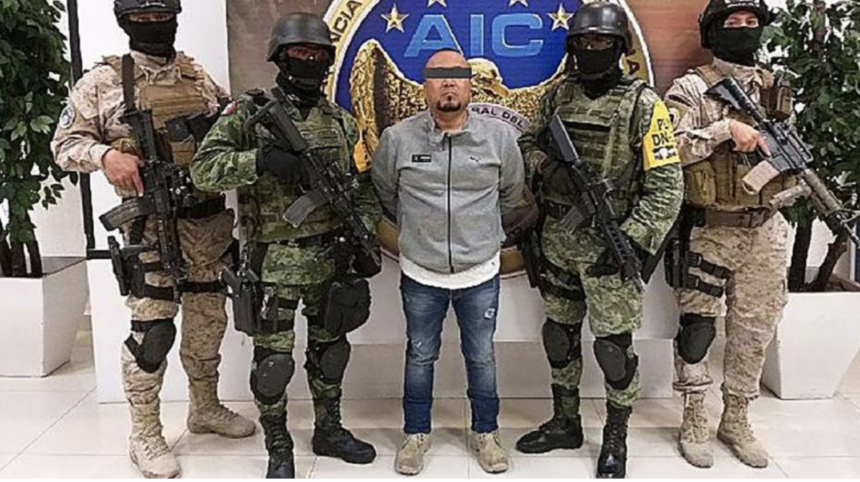Mexico arrests violent gang leader known for emotive videos

MEXICO CITY (AP) — Mexican police and military forces on Sunday arrested the leader of the Santa Rosa de Lima gang who spread violence through north-central Mexico and fought a years-long bloody turf battle with the Jalisco cartel.
The armed forces and officials in the state of Guanajuato said they had captured José Antonio Yépez Ortiz, better known by his nickname “El Marro,” which means “The Sledgehammer.”
Yépez Ortiz was unusual among gang leaders because he posted videos with emotional calls to his followers, including one in June showing him appearing to cry after several of his supporters and relatives were arrested. In another video around the same time, he threatened to join forces with the Sinaloa cartel to defeat Jalisco, Mexico’s fastest-rising drug cartel.
The turf battle with Jalisco turned the industrial hub of Guanajuato, with its foreign auto plants and parts suppliers, into the most violent state in Mexico, with 2,293 murders in the first six months of this year. The Santa Rosa gang has been blamed by some observers for the July attack on a drug rehabilitation center in the city of Irapuato in which 27 men were killed.
But Mexico’s top civilian security official, Alfonso Durazo, said Yépez Ortiz would be charged with organized crime and fuel theft, not murder. President Andrés Manuel López Obrador — whose administration has said its main goal is no longer to detain gang leaders — praised the arrest, calling it “important, very important,” noting that 15% of Mexico’s murders in recent months had happened in Guanajuato.
“Of course, we have to continue addressing the root causes of the violence, first, that poverty be eliminated,” said López Obrador, adding “second, that there be no more corruption,” noting that gangs like Yépez Ortiz’s could not have grown into such a problem without “the complicity, the cooperation of local and state authorities.”
Yépez Ortiz had been the subject of massive manhunts for years, and was caught along with five other suspects allegedly holding a kidnapped businesswoman. He was among Mexico’s most wanted suspects, trailing Jalisco cartel leader Nemesio “El Mencho” Oseguera and Sinaloa cartel leader Ismael “El Mayo” Zambada.
His Santa Rosa gang was not a drug cartel, but rather a powerful, violent gang that grew up in a farming hamlet of the same name in north-central Guanajuato state by stealing fuel from government pipelines and refineries and robbing freight from trains.
The Santa Rosa gang was also unusual in that it tried to build a support network among local residents by allowing them to take a minor share in the spoils of the robberies. But when authorities stepped up security around the trains and pipelines over the last two years, the gang turned to extortion and kidnapping. The gang would move sector to sector, systematically demanding extortion payments from businesses like tortilla shops or car dealerships.
However, the gang’s reign never affected the major companies that have built dozens of plants in Guanajuato, attracted by investor-friendly policies and excellent rail and highway links.
True to his humbler circumstances, the short, round-faced Yépez Ortiz was shown wearing a gray hoodie, ripped jeans and construction boots in official photographs distributed by the Guanajuato state government.
The army said in a statement that he was caught in a raid near Santa Rosa de Lima, based on intelligence work that indicated members of the gang were at two houses. Yépez Ortiz was detained along his security chief, four other gang members, five rifles, three pistols and a grenade launcher.
A lot of mythology had grown up around “El Marro,” including the belief that he and a close band of supporters had been able to escape police for years by encouraging townspeople to throw up impromptu roadblocks to give him enough time to escape over dirt roads on ATVs. One ATV was found during Sunday’s raid.
Guanajuato state Security Commissioner Sofia Huett said earlier this year the gang may have called itself a cartel, but largely operated only in Guanajuato, jumping from one illegal activity to another.
“At one time they were gangs, not big cartels, that robbed trains,” Huett said.
After security forces cracked down on that, the gang started to drill illegal taps into fuel pipelines and allowed locals to fill plastic tanks with gasoline or diesel. Always known for a propensity for violence, the Santa Rosa de Lima gang started stealing fuel directly from government oil refineries by the truckload. But when the government began stepping up security, they turned to other crimes.
“With less access to gasoline, these groups migrated to other crimes, like street-level drug dealing and auto theft and extortion,” Huett said.
Santa Rosa de Lima was precisely the kind of local gang that the Jalisco cartel has deftly taken over in the past in its relentless expansion across Mexico, co-opting local gang members in a sort of franchise scheme.
There are reports that Oseguera sent a nephew to Guanajuato in 2017 to negotiate a deal with the Santa Rosa gang which would allow Jalisco to traffic drugs in the state while the local gang would keep the fuel theft business.
But the pugnacious Yépez Ortiz — his videos are punctuated by cursing — vowed never to let in the cartel from neighboring Jalisco state. A deadly feud ensued.
It was unclear if the arrest of Yépez Ortiz would mean that Jalisco may now be poised to roll into Guanajuato as it has in so many other states.
In July, the Jalisco cartel posted a video that Mexican defense officials said was apparently filmed near the border of Jalisco and Guanajuato states. Officials said the video showed a column of about 75 Jalisco cartel gunmen dressed in military-style fatigues with a dozen homemade armored pickup trucks, an anti-aircraft gun, nine belt-fed machine guns, 10 sniper rifles, six grenade launchers and 54 assault rifles.